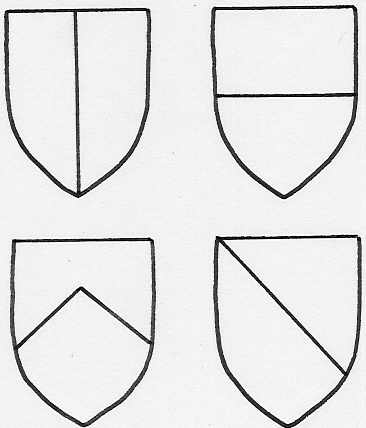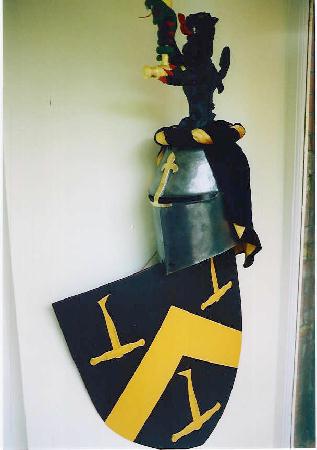
The Coat of Arms:
Strictly speaking the term coat of arms refers only to what is borne on the shield and the expressions armorial bearings and achievement of arms more correctly describe the combination of shield, helm, crest, wreath and mantling that together constitute the arms. However, the term coat of arms has, by common usage, come to mean the full armorial bearings.
On the other hand it is quite incorrect to refer to the arms as a family crest. The crest is an object mounted on top of the helm, and although it is an integral part of the coat of arms the term should never be used to describe the arms or the whole achievement.
The Shield:
The shield is the most important element of the coat of arms and, together with the banner is the principal means of heraldic display. For it is on the shield and banner that the charges are borne that go to make the arms. The whole point of heraldry was to have an instantly recognisable device that would identify an individual. Hence the design of the shield needs to be at once simple and unique. Early arms followed this dictum, but in the 18th. and particularly 19th. centuries the design of the arms became more and more complex, as the original purpose of identification on the battlefield became lost. Nowadays it is pleasing to see that, wherever possible, new grants of arms have a tendency to follow the more simple medieval style.
The shield is divided into the top or chief, the bottom or base, and right - dexter and left sinister. Right and left follow the same rules as are used in anatomy, i.e. one assumes the shield is being held by ones opponent and the dexter side corresponds with his right.

Shields divided ( clockwise from top left ) - per pale; per fess; per bend; per chevron.
The principal charge on the shield is called an ordinary. This is a bold rectilinear shape such as a vertical bar or pale, or horizontal bar or fess. Other ordinaries are the bend, which runs diagonally, the chevron, which resembles an inverted letter 'V', the cross, as exemplified by the cross of St. George and the saltire, which is a cross formed by diagonal bars. A pall, resembles the letter 'Y' and both the chevron and the pall can be depicted reversed. Lesser charges on the shield depict any variety of animals and objects.
Basically heraldry uses two metals - gold and silver ( or and argent ) and the colours red ( gules ); blue ( azure ); black ( sable ); green ( vert ); purple ( purpure ); and mulberry ( murrey ). These are known as tinctures. The fundamental rule of armory is that a metal should not lie on a metal, nor a colour on a colour. This has been universally accepted from the earliest times and is clearly intended to enable the identication of heraldic devices from a distance. It is obviously easier to see a gold chevron on a black background than it would be to see a blue chevron similarly placed. This rule only applies to charges placed upon a field or on another charge, but not to adjacent divisions or partitions of the shield. So it is perfectly acceptable to have a shield divided vertically, or per pale, black and red - but not to have a red vertical bar on a black field or background.

Arms showing shield; helm; wreath; mantling or lambrequin; crest.
The Helm:
This sits above the shield and it's character denotes the rank of the individual. A gentleman has a steel helm - this may be a tilting helm, a pot helm or a close helm with the visor down - and is placed sideways facing the right of the shield. Baronets and knights have a visored helm of steel adorned with silver. These are shown facing forward, or affronte, with the visor raised. Peers have a barred helm of silver, the bars being gold, placed sideways and showing five bars.

Examples of Helm used in heraldry. Clockwise from top left - barrel helm; tilting helm; barred helm; armet.
The crest:
This is the device that sits atop the helm and, as has been said previously, should never be used as a term to describe the arms themselves. Originally these were simple fan-like boards the sides of which were painted with heraldic devices similar to those borne on the shield. Later these became more ornate and three-dimensional depictions of animals or objects were fashioned in pasted cloth or boiled leather over a wooden or wire framework. Only a man can possess a crest in his arms and one can have arms without a crest ( a lady bears arms on a lozenge-shaped shield but has no crest ), but never a crest without the accompanying arms. The crest would have been attached to the helm using laces or rivets and one objective in the tilt was to strike ones opponent's crest, hence the expression to look 'crestfallen'.
The wreath and mantling:
The wreath is a twisted band of cloth in two tinctures, being those of the principal metal and colour of the shield. It is shown twisted in such a way that three bands of the metal are shown alternating with three bands of the colour, always starting from the left with a metal. The wreath is shown above the helm and acts to conceal the base of the crest where it is laced or bolted to the helm. The crest is described as being "......upon a helm within a wreath........".
The mantling or lambrequin is a cloth depicted as flowing from beneath the wreath. It is shown as slashed or scalloped in a stylized form, sometimes terminating in tassels. It almost certainly originated in the Holy Land where it was worn by crusading knights to absorb the sun's heat and thus preventing the helm from becoming unbearably hot. Like the wreath it is of the principal metal and colour of the arms and is always shown with the metal forming the inner lining.
Having given a brief outline of the basics of heraldry in the next page I will be showing a number decorative useages, together with the various stages involved in depicting a coat of arms in a variety of materials.